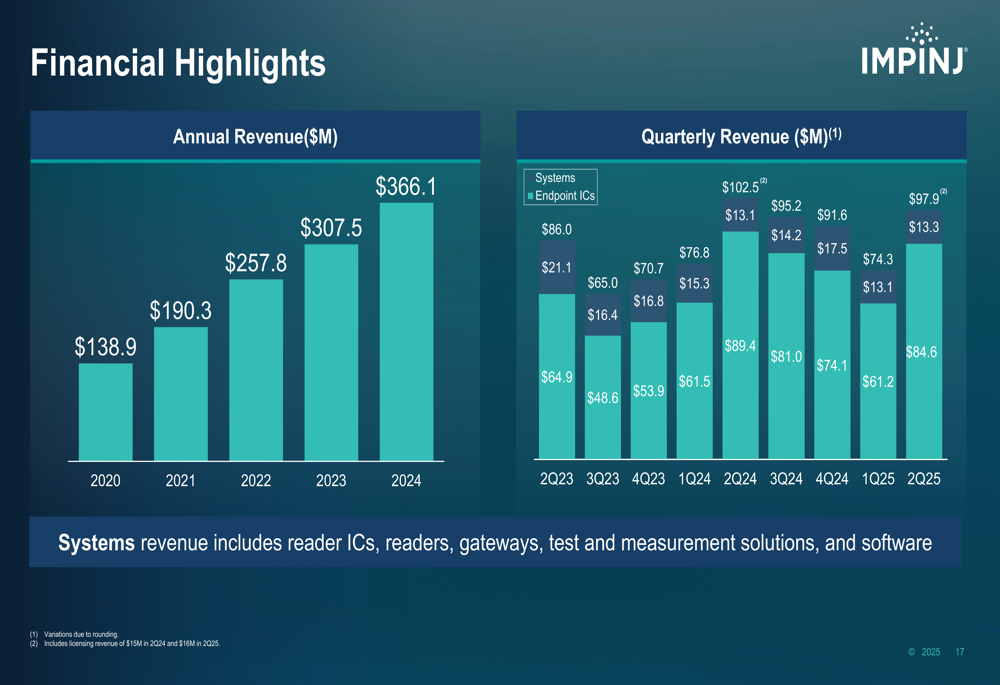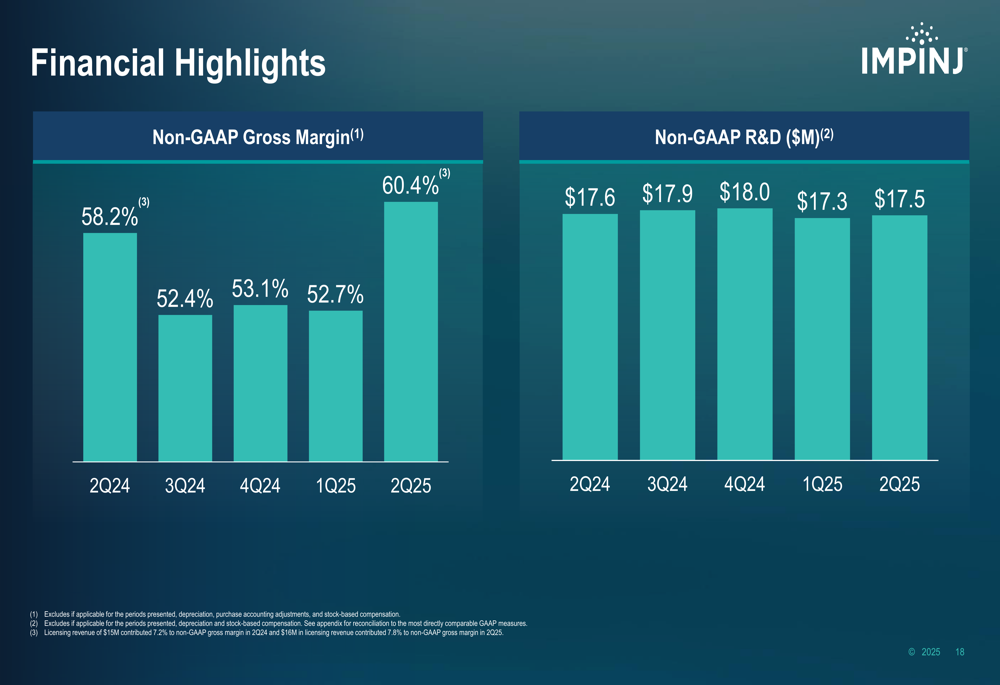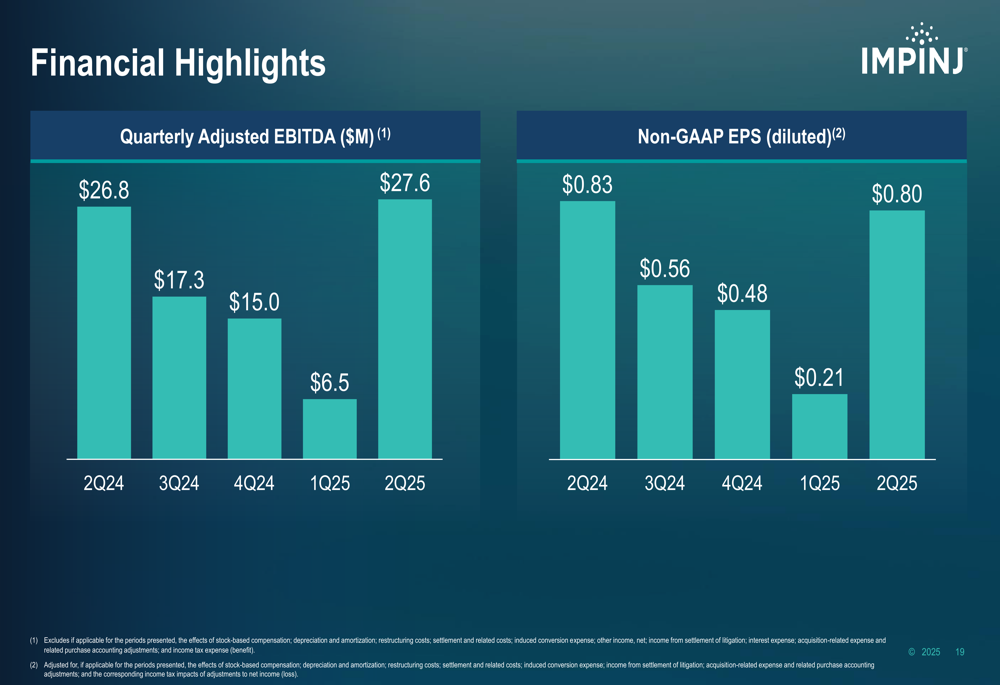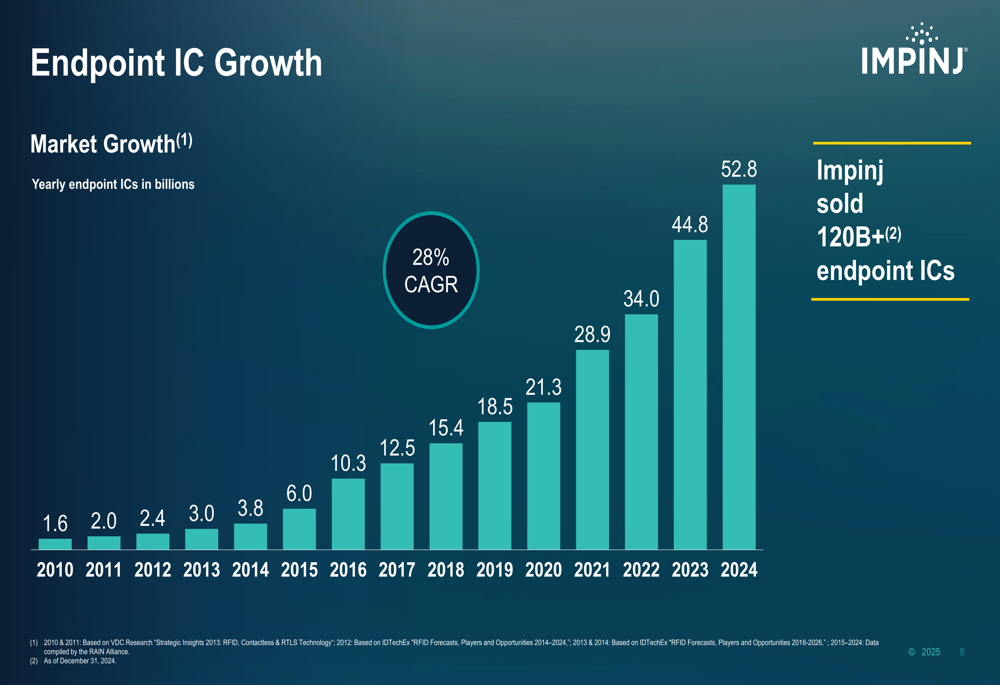Top U.S. Defense Stocks to Watch According to Jefferies Analysis
Introduction & Market Context
Impinj Inc (NASDAQ:PI) has delivered exceptional second-quarter 2025 results that dramatically exceeded previous guidance, according to the company’s latest investor presentation. The RAIN RFID technology provider reported Q2 2025 revenue of $200.4 million, more than doubling from the previous quarter and surpassing its earlier guidance of $91-96 million by over 100%. Following these results, Impinj’s stock closed at $122.81 on July 30, 2025, with after-hours trading pushing it up another 1.69% to $124.88.
The company’s remarkable performance comes amid growing adoption of RFID technology across multiple industries, with Impinj’s platform enabling the tracking and identification of everyday items in retail, supply chain, and logistics environments.
Quarterly Performance Highlights
Impinj’s Q2 2025 results showed significant improvement across all key financial metrics. Revenue reached $200.4 million, comprising $97.9 million from Systems and $102.5 million from Endpoint ICs, including $16 million in licensing revenue. This represents a 170% increase from Q1 2025’s $74.3 million and substantially exceeds analyst expectations.
As shown in the following quarterly revenue breakdown:

The company’s non-GAAP gross margin improved to 60.4% in Q2 2025, up from 52.7% in Q1 2025, demonstrating enhanced operational efficiency and favorable product mix.

Profitability metrics also showed substantial improvement, with adjusted EBITDA reaching $27.6 million in Q2 2025, compared to just $6.5 million in Q1. Non-GAAP diluted EPS jumped to $0.80, nearly quadrupling the $0.21 reported in the previous quarter.

These results build upon Impinj’s Q1 2025 performance, which had already exceeded analyst expectations with EPS of $0.21 versus a forecasted $0.09, as reported in the company’s earlier earnings announcement.
Market Opportunity (SO:FTCE11B) & Strategy
Impinj’s presentation highlights the massive untapped market opportunity for RAIN RFID technology. In 2024, the technology enabled connectivity for over 52 billion items, yet this represents only approximately 0.5% of potentially connectable items globally.
The company’s addressable market spans trillions of items across various sectors, including 3 trillion in food and drink packaging, 600 billion in auto parts, 400 billion in parcels and postal, and 325 billion in general merchandise, among others.
As illustrated in this market opportunity visualization:

Impinj’s success strategy focuses on four key elements: developing whole-platform solutions for lighthouse enterprises, winning the endpoint IC opportunity at those enterprises, engaging partners to repeat successes at other accounts, and competing aggressively for the rest of the endpoint IC market.
The company provides a comprehensive overview of its position and vision:

The historical growth of endpoint ICs demonstrates the expanding adoption of RAIN RFID technology, with the market showing a 28% CAGR and reaching 52.8 billion units in 2024:

Detailed Financial Analysis
Beyond the headline revenue and earnings figures, Impinj’s financial position continues to strengthen. As of June 30, 2025, the company reported $260.5 million in cash and investments, alongside $287.5 million in convertible debt. The trailing twelve-month adjusted free cash flow stood at $27.5 million.
The company’s free cash flow showed significant improvement, turning from negative $13.0 million in Q1 2025 to positive $27.3 million in Q2 2025. This recovery aligns with the substantial revenue increase and improved operational efficiency.
Impinj maintains $190.3 million in federal net operating losses (NOLs) as of December 31, 2024, which will help shield future profits from taxation. The company also emphasizes its scalable, asset-light manufacturing model as a key advantage in maintaining capital efficiency.
Strategic Initiatives
Impinj’s presentation outlines several strategic initiatives driving its growth. The company focuses on retail and supply chain & logistics as primary vertical markets, with applications ranging from inventory management and sales floor replenishment to shipment verification and loss prevention.
The company’s recurring revenue strategy centers on authentication services, which utilize the entire Impinj platform to ensure products are genuine. This service monetizes both endpoint ICs and the authentication service itself, creating a sustainable revenue stream beyond hardware sales.
Impinj’s partner ecosystem plays a crucial role in its go-to-market strategy. By leveraging enterprise learnings, advancing its platform, and enabling partner solutions, the company aims to win the majority of endpoint IC market share while driving recurring revenue.
Forward-Looking Statements
While specific forward guidance wasn’t detailed in the presentation slides, Impinj’s Q2 2025 results significantly exceeded the guidance provided after Q1 2025, which had projected Q2 revenue between $91-96 million and non-GAAP EPS between $0.68-$0.76. The actual results of $200.4 million in revenue and $0.80 in non-GAAP EPS demonstrate the company’s ability to capitalize on growing market demand.
CEO Chris Diorio had previously expressed confidence in the company’s long-term growth trajectory despite macroeconomic uncertainties. The Q2 2025 results appear to validate this optimism, showing Impinj’s ability to extend its technology leadership, market share, and platform adoption.
The presentation highlights potential growth drivers, including the vast untapped market for RAIN RFID technology across multiple industries. With only 0.5% market penetration to date, Impinj is positioned to benefit from continued adoption of its technology in retail, supply chain, logistics, and emerging applications like food and consumer markets.
As RFID technology becomes increasingly essential for inventory management, supply chain visibility, and authentication in a digital economy, Impinj’s comprehensive platform approach and established market position suggest continued growth potential despite competitive pressures and economic volatility affecting enterprise spending.
Full presentation:
This article was generated with the support of AI and reviewed by an editor. For more information see our T&C.
